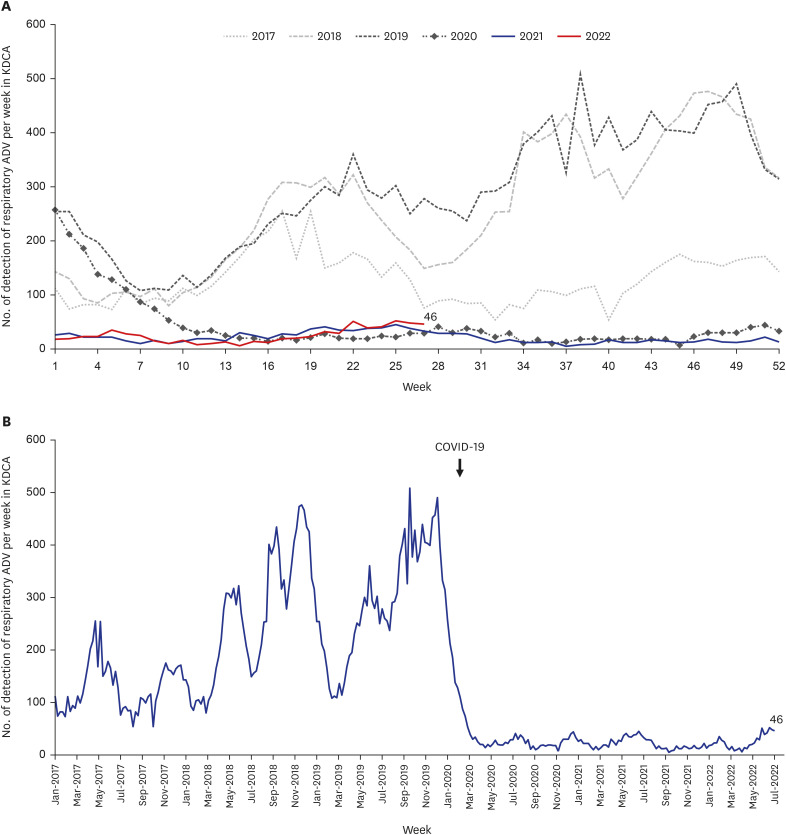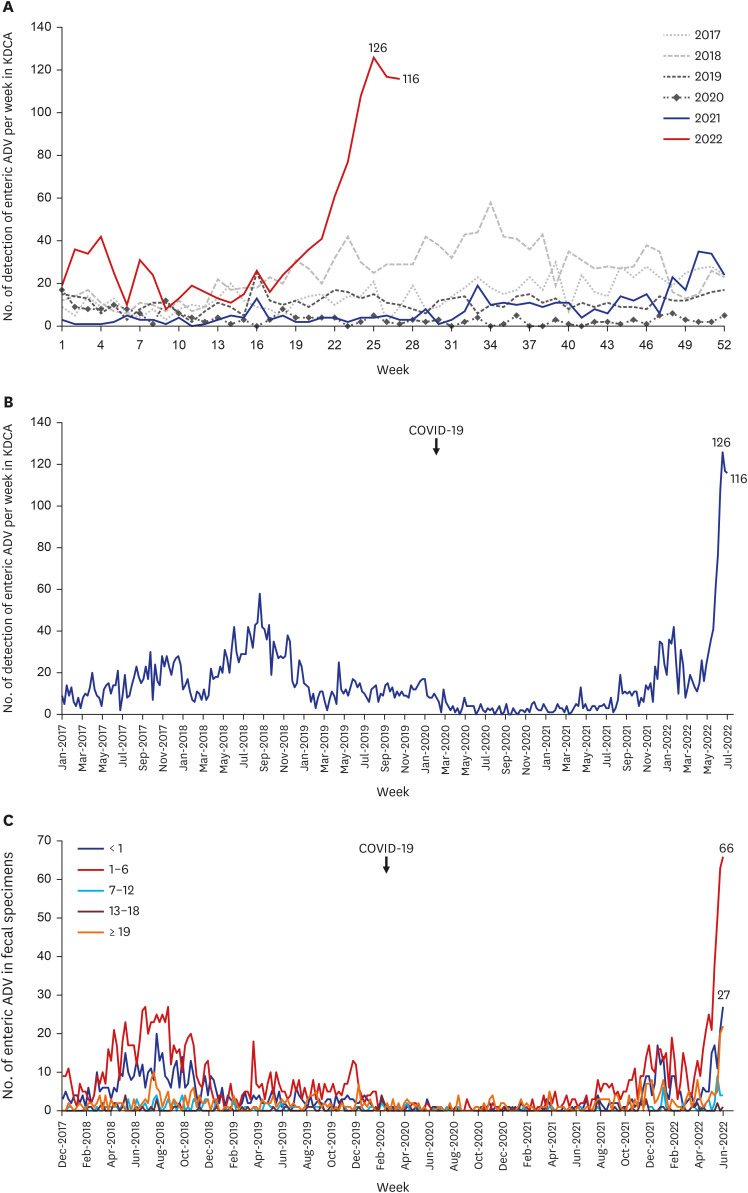J Korean Med Sci.
2023 Mar;38(9):e71. 10.3346/jkms.2023.38.e71.
The Changes in Respiratory and Enteric Adenovirus Epidemiology in Korea From 2017 to June 2022
- Affiliations
-
- 1Department of Pediatrics, Gyeongsang National University Changwon Hospital, Changwon, Korea
- 2Division of Infectious Disease Control, Korea Disease Control and Prevention Agency, Cheongju, Korea
- 3Department of Pediatrics, Samsung Medical Center, Sungkyunkwan University School of Medicine, Seoul, Korea
- KMID: 2540128
- DOI: http://doi.org/10.3346/jkms.2023.38.e71
Abstract
- Since October 2021, severe acute hepatitis of unknown etiology in pediatric patients has been observed in many countries around the world. Adenovirus (mainly enteric adenovirus) was detected in more than 50% of the cases. Nationwide surveillance on acute hepatitis of unknown etiology in pediatric patients was started in May 2022 in Korea. Taking into account the severity of the illness and the urgency of the epidemiological situation worldwide, we report a summary of changes in adenovirus epidemiology during the past five years and six months in Korea.
Figure
Cited by 1 articles
-
A Report on a Nationwide Surveillance System for Pediatric Acute Hepatitis of Unknown Etiology in Korea
Kyung Jae Lee, Jae Sung Ko, Kie Young Park, Ki Soo Kang, Kunsong Lee, Jeana Hong, Soon Chul Kim, Yoon Lee, Ben Kang, Yu Bin Kim, Hyun Jin Kim, Byung Wook Eun, Hye-Kyung Cho, Yae-Jean Kim, Mi Jin Kim, Jin Lee, Taek-Jin Lee, Seak Hee Oh, Sowon Park, Eun Ha Hwang, Sangjun Sohn, Jin Gyu Lim, YooJin Kim, Yeoun Joo Lee
J Korean Med Sci. 2023;38(47):e401. doi: 10.3346/jkms.2023.38.e401.
Reference
-
1. U.K. Health Security Agency. Investigation into acute hepatitis of unknown aetiology in children in England. Technical briefing. Updated 2022. Accessed October 18, 2022. https://assets.publishing.service.gov.uk/government/uploads/system/uploads/attachment_data/file/1071198/acute-hepatitis-technical-briefing-1_4_.pdf .2. Marsh K, Tayler R, Pollock L, Roy K, Lakha F, Ho A, et al. Investigation into cases of hepatitis of unknown aetiology among young children, Scotland, 1 January 2022 to 12 April 2022. Euro Surveill. 2022; 27(15):2200318. PMID: 35426362.3. World Health Organization. Multi-country – acute, severe hepatitis of unknown origin in children. Updated 2022. Accessed June 29, 2022. https://www.who.int/emergencies/disease-outbreak-news/item/2022-DON376 .4. Kelgeri C, Couper M, Gupte GL, Brant A, Patel M, Johansen L, et al. Clinical spectrum of children with acute hepatitis of unknown cause. N Engl J Med. 2022; 387(7):611–619. PMID: 35830627.5. Baker JM, Buchfellner M, Britt W, Sanchez V, Potter JL, Ingram LA, et al. Acute hepatitis and adenovirus infection among children - Alabama, October 2021-February 2022. MMWR Morb Mortal Wkly Rep. 2022; 71(18):638–640. PMID: 35511732.6. World Health Organization. Acute hepatitis of unknown aetiology in children - multi-country. Updated 2022. Accessed June 27, 2022. https://www.who.int/emergencies/disease-outbreak-news/item/DON-389 .7. U.K. Health Security Agency. Investigation into acute hepatitis of unknown aetiology in children in England. Technical briefing 4. Updated 2022. Accessed October 18, 2022. https://assets.publishing.service.gov.uk/government/uploads/system/uploads/attachment_data/file/1094573/acute-hepatitis-technical-briefing-4.pdf .8. Centers for Disease Control and Prevention. Technical report: acute hepatitis of unknown cause. Updated 2022. Accessed October 18, 2022. https://www.cdc.gov/ncird/investigation/hepatitis-unknown-cause/technical-report.html .9. Korea Disease Control and Prevention Agency. Execution of extension of confirmation of rapid antigen test by medical institutions (May 10, regular briefing). Updated 2022. Accessed June 23, 2022. https://kdca.go.kr/board/board.es?mid=a20501020000&bid=0015&list_no=719514&cg_code=C01&act=view&nPage=9#Updated .10. Korea Disease Control and Prevention Agency. Infectious disease portal. Updated 2022. Accessed October 18, 2022. https://www.kdca.go.kr/npt/biz/npp/iss/influenzaStatisticsMain.do .11. U.K. Health Security Agency. Research and analysis. Investigation into acute hepatitis of unknown aetiology in children in England: case update. Updated 2022. Accessed July 11, 2022. https://www.gov.uk/government/publications/acute-hepatitis-technical-briefing/investigation-into-acute-hepatitis-of-unknown-aetiology-in-children-in-england-case-update .12. Kimberlin DW, Barnett ED, Lynfield R, Sawyer MH. Adenovirus infections. Red Book. 32nd ed. Itasca, CA, USA: American Academy of Pediatrics;2021. p. 189–190.
- Full Text Links
- Actions
-
Cited
- CITED
-
- Close
- Share
- Similar articles
-
- Clinical Features and Role of Viral Isolates from Stool Samples of Intussuception in Children
- Coinfection of Viral Agents in Korean Children with Acute Watery Diarrhea
- Epidemiology of Acute Viral Lower Respiratory Tract Infection in Hospitalized Children in Two Different Areas of Korea
- Viral Etiology and Epidemiology of Outpatients with Acute Respiratory Illnesses in Busan: 2007-2008
- Epidemiology of acute viral resp iratory tract infections in Busan (2004–2006)



